|
Nursultan Nazarbaev
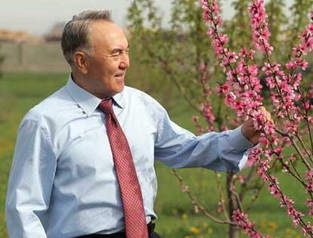
President of Kazakhstan
=================================================================
The GHA highest award “Crystal of Harmony” to the President of Kazakhstan Nursultan Nazarbaev
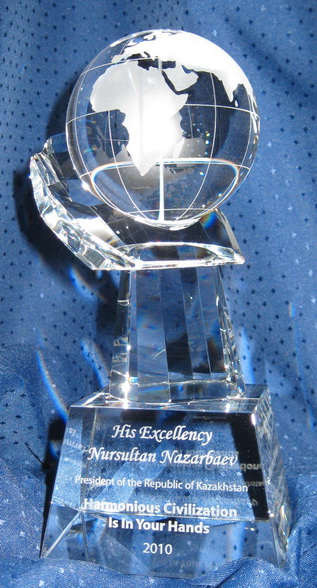
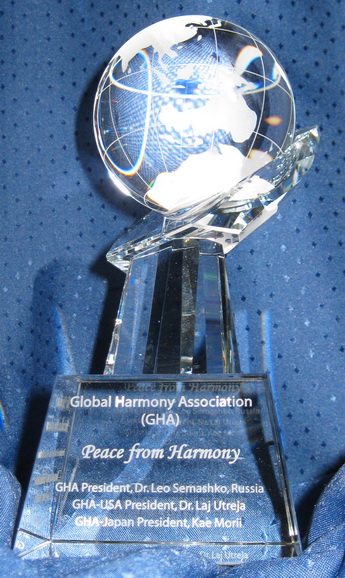
----------------------------------------------------------------------------------------------------------------------
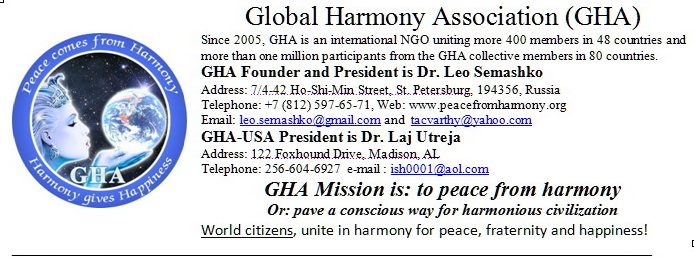
September 27, 2010
GHA confers the High Honor World Harmony Creator on His Excellency Nursultan Nazarbaev President of the Republic Kazakhstan In marking his status as ‘Leader of the nation’ and In his unprecedented contribution to global harmonization, expressed in: • Conducting of unswerving policy of the Eurasian harmony for about 20 years • Defining Kazakhstan’s mission as harmony center of the peoples of Europe and Asia • Initiating the regular global Forums of Spiritual Culture and Harmony • Instituting in the country since 1992 Spiritual Harmony Day on October 18 • Accepting the historic “Eurasian Charter for Peace and Harmony" in 2003, • Building Astana as the new capital of Kazakhstan, entering the threshold of a new, harmonious, civilization. Your unique contribution to the new civilization found international recognition long ago. It was expressed by the Pope Paul II visiting Astana in 2001, “Indeed, in your country the world can see accord and harmony between different peoples … to live together in peace … Kazakhstan is a country of harmony.” Under the leadership of President Nursultan Nazarbayev and with the "Strategy of Harmonism" Kazakhstan will become the cradle and the leader of a harmonious civilization in the 21st century.
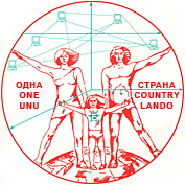
Dr. Leo Semashko, GHA President
Dr. Laj Utreja,
GHA-USA President =================================================================== 25.07.2006 , Kazakhstan Today news agency
ASTANA. Nursultan Nazarbayev, President of Kazakhstan, visited the Palace of Peace and Harmony under construction at the Right Bank of Ishim river in Astana according to a design by British architect Norman Foster, presidential press service told Kazakhstan Today. The Palace of Peace and Harmony will be commissioned this autumn. The second Forum of Leaders of World and Traditional Religions is planned to be held there, in which representatives of religious currents and creeds from the whole world plan to participate.
The Palace of Peace and Harmony will include the following premises: a Museum of National Culture of Kazakhstan, an Opera Theatre for 1,500 seats, a University of Civilisations, exposition and concert halls, libraries, as well as a research centre of world religions and spiritual offices. The hall in which the meeting of religious leaders is expected to take place is designed on the example of a Conference Hall of the UN Security Council in New York. The altitude of the building is 77 metres, the total area - 25.5 thousand square metres. The general contractor is "Sembol Inshaat" from Turkey. http://eng.gazeta.kz/art.asp?aid=78289
Visiting Astana, the capital, in September 2001, Pope John Paul II said: "From Kazakhstan, a country that is an example of harmony between men and women of different origins and beliefs, I wish to make an earnest call to everyone, Christians and the followers of other religions, to work together to build a world without violence, a world that loves life, and grows in justice and solidarity." Sydney, 30 September 2005 Opening of the Multifaith Conference for Peace and Harmony ------------------------------ II Congress of world and traditional religions
II Congress of world and traditional religions was held in capital city Astana of the Republic of Kazakhstan on 12-13 September, 2006.
Three years later after I Congress, leaders of world and traditional religions met each other in Astana again, and discussed such matters as religious freedom, inter-religious dialogue, and the role of religious leaders in strengthening global security.
The participants adopted a declaration on the results of the Congress, which states their visions of religions’ role in the modern world. The declaration incorporates the agreements achieved over the triennial period of joint work and dialogue, oriented to strengthening the role of leaders of world and traditional religions in processes of establishing global peace.
Representatives from Islam, Christianity, Buddhism, Judaism, Taoism and Shinto, international religious organizations including World Conference of religions supporting peace, World Council of Churches were invited to participate in the Congress. ----------------------------------
Velimir Linderman
The Path to Peace and Harmony The Euro-Asian Jewish Congress (EAJC) was destined to emerge during a period of great difficulty for the Old World as well as for the entire world. A number of events and developments of the recent years have caused humankind to look anxiously into the future. The merciless terrorist attack on the United States and the riposte that followed, along with activity on several of the “local fronts” of the global fight against terrorism, have made the experts ask a pessimistic question: Don’t these separate fragments taken all together comprise a horrifying mosaic known as the Clash of Civilizations? What if those gloomy Cassandras are right, those whose prophecies have been almost all ignored, those who foretold of the inevitable conflict between the East and the West, or to use the more popular terms – between the Judeo-Christian and the Muslim civilizations? Fortunately, simplistic patterns and clich`s don’t always match realities, and the experts can also sometimes be wrong. The clash of civilizations is a myth whose only benefit is to those who act according to the principle: “the worse, the better”. There are no eternal differences that necessarily lead to a conflict between the Muslim world and Western civilization. There is even less cause for contention in terms of Jewish-Muslim relations, which, if one looks back in history, were nearly always much more amicable than Jewish-Christian relations. Anti-Jewish sentiments of the modern-day Muslims (where they actually occur) are not a result of everlasting and fundamental conflicts of religion, but rather a consequence of the local Palestinian-Israeli political conflict, or to put it more precisely – the exploitation of this conflict by some unscrupulous political profiteers. one can expand the boundaries of this conflict and interpret it as an “Arab-Israeli” dichotomy (and today this is obviously not the case because Egypt and Jordan, for instance, have long since realized that cooperation with Israel brings much more profit than fighting with her; sooner or later, every country of that region will come to the same understanding). But even so, the majority of the Muslim population of our planet is not Arab, and they stand far away from the Middle-East conflict. Extremists that kindle hatred and exploit political contradictions for their own ends represent views far from those of Islam, which is a peace-loving religion in its essence, or of the overwhelming majority of Muslims. Peace and harmony between civilizations is possible. The Euro-Asian Jewish Congress has dared to attempt to demonstrate this point; moreover, it has already proven it. Leaders of the Congress set forth the task of accomplishing a fruitful and benevolent dialogue between civilizations right after its creation on March 5, 2002. As EAJC President Alexander Mashkevich later said in an interview to the oldest American Yiddish newspaper, the “Forverts”, “We began this dialogue even from the first days of the Congress’s existence”. I suppose we can’t say that this has been an easy road, but the results achieved are impressive. Thanks to the support of the leadership of the Republic of Kazakhstan and the personal backing of President Nursultan Nazarbayev, in less than a year the Congress did something no one else had ever done. Heads of state in countries with predominantly Muslim populations, international diplomats, representatives of Jewish organizations, rabbis and Muslim theologians, spiritual leaders of the Jews and Muslims came together, sat at one table, and found common ground without much difficulty… And that’s only the beginning. EAJC’s experience in striving for peace and harmony is unique and deserves close attention. The “launching pad” for establishing a dialogue between the East and the West, among Muslims, Jews and Christians, became Kazakhstan, for a whole number of objective and subjective reasons. A vast country located in the center of Asia, precisely because of this geographical position, Kazakhstan plays the role of a bridge between civilizations. But the main point is not only that EAJC headquarters is located in Kazakhstan; it’s not even that the leadership of that country willingly supported the striving of the Jews and Muslims towards a dialogue – an unprecedented case! – and did its best to promote it. The main point is simply that Kazakhstan is a country where East and West meet, where peaceful and harmonious co-existence of various civilizations has already been achieved, together with mutual understanding between different religions. The experience of Kazakhstan, which is truly a land of peace and harmony, deserves to be exported. That is why the main events of the process under examination took place in Kazakhstan. In late October 2002, a conference in Kazakhstan gathered the most authoritative rabbis from different corners of the world. They established the Council of Rabbis of the EAJC. Chief Rabbi of Kazakhstan Yeshaia Kohen became its head, while Chief Rabbi of Russia Adolf Shayevich became his deputy. Participants in the conference, that is, members of the Council of Rabbis of the EAJC, met with representatives of the Spiritual Department of the Muslims of Kazakhstan. EAJC President Alexander Mashkevich spoke on his initiative to hold meetings in Alma-Ata and Astana. He had the support of President Nursultan Nazarbayev of Kazakhstan. The meeting resulted in a small sensation: the signing of a joint memorandum that declares that there are no fundamental differences between Islam and Judaism, and that terrorism is condemned by every religious authority. on top of that, the memorandum encourages continued contacts between Jews and Muslims at all levels. Nothing of this kind has ever happened before. The Jewish-Christian religious dialogue has long since started – after the Holocaust Christian churches stepped out to meet the kindred Abrahamic religion. But there has never been a full-fledged dialogue between Jewish and the Muslim clergy despite the objective closeness of the two religions (while Judaism may claim that Christianity has departed from strict monotheism, none of such claims can be made against Islam). Rather, political games and negative stereotypes have always stood in the way. And, there, right in front of our eyes, a new page was written in the history of inter-religious relations; its true significance has yet to be fully recognized. So, on February 12-13, 2003, a grand event took place – the First International Conference of Peace and Harmony was called on the initiative of the president of Kazakhstan. The Ministry of Foreign Affairs of Kazakhstan and the EAJC organized it. Presidents and diplomats of a number of Central Asian countries, as well as Muslim theologians and clergy met with leaders of major Jewish organizations from the United States and Eurasia. Delegates from 15 countries and 70 Jewish organizations attended the conference, in particular, more than 60 leaders of the Conference of Presidents of Major Jewish Organizations of the USA with its head M. Zuckerman and Senator R. Boshovits. Among members of the American delegation were WJC secretary general A. Becker, executive director of the American Jewish Committee A. Baker, and executive director of the National Conference for Defense of Former Soviet Jews, M. Levin. President Nursultan Nazarbayev of Kazakhstan, President Emomali Rakhmonov of Tajikistan and President Askar Akayev of Kyrgyzstan also attended the conference. Azerbaijan, Afghanistan and Turkey were represented by their foreign ministers. The presidents of the USA, Ukraine, Turkey, and the prime minister of Israel sent greetings to the participants in the forum. Along with representatives of Jewish communities and diplomats, clergy also played a great part in the conference, in particular, supreme hierarchs of the spiritual departments of the Muslims of Central Asia, including the Grand Mufti of Kazakhstan A. Derbisali and the heads of dioceses of the Russian Orthodox and Roman Catholic Churches. As a result of the work of the conference, the Eurasian Charter of Peace and Harmony was signed. Participants in the conference «recognized the right of every person to freely follow his religious convictions and highly evaluated the contribution of religious leaders in promoting peace and stability”. They resolutely condemned the use of religion by terrorist and separatist movements and groups as a means of achieving their goals. According to the Charter, there is no conflict of civilizations determined by religious contradictions: there is nothing in the Abrahamic religions that would make believers hate one another. Diplomats and representatives of different denominations expressed willingness to work together on reaching peace and safety in the region and in the whole world. It was also decided to deliberately and systematically deepen the dialogue between religions starting from their common values, ideals and views regarding good, evil, justice, and so on. A standing Forum on Peace and Stability was set up to secure and implement the decisions made at the conference. Work on the development of the dialogue will continue. The Second Conference of Peace and Harmony is scheduled for the end of 2003. Its purpose is to specify the real steps towards establishment of such a dialogue, to move it from the sphere of declarations to the sphere of real political practice. EAJC leaders are certain that this is possible. MAGAZINE «JEWS OF EURO-ASIA» April – September 2003 http://www.eajc.org/publish_gen_e.php?rowid=26 ----- First congress of world and traditional religions in Astana
Leaders and senior representatives of all the world's major faiths closed their two-day meeting in Astana September 24, 2003 with a strong condemnation of terrorism and prophecies of a "clash of civilizations". They pledged to continue dialogue in the name of peace, harmony and prosperity.
This was the first ever Congress of Leaders of World and Traditional Religions. The Congress, held at the initiative of President Nursultan Nazarbayev in Kazakhstan's capital, drew wide-spread support from political leaders of both Western and Asian nations. Kazakhstan is a Muslim-majority country and is considered an example of interethnic and interfaith harmony. The Congress was a bold reminder to the world that people of different faiths and ethnic backgrounds really can and should live together in peace.
At the end of the Congress, senior clerics from Islam, Christianity, Buddhism, Judaism, Hinduism, Taoism and other faiths adopted a Declaration stating that "extremism, terrorism and other forms of violence in the name of religion have nothing to do with genuine understanding of religion, but are threat to human life and hence should be rejected."
"The inter-religious dialogue is one of the key means for social development and the promotion of the well-being of all peoples, fostering tolerance, mutual understanding and harmony among different cultures and religions," the religious leaders said after the closing joint prayer.
President Nazarbayev, who chaired the conference, said, "it is unacceptable to attach ideological or political dimensions to existing cultural and religious differences." He countered the notion of the "clash of civilizations", saying it would be more appropriate to talk about "a meeting of civilizations".
The UK Prime Minister Tony Blair said in his message to the participants of the Congress: “…The aims and objectives of the Congress recognise the continuing importance of open dialogue of mutual understanding between the religions of the world. Religion, whatever the faith, has an important role in promoting peace and harmony among the peoples of the world, now and in future…”
Baroness Thatcher has also supported the Congress and in her letter to President Nazarbayev she wrote: “… By understanding one another’s beliefs better we can hope to avoid the suspicions which some seek to promote hatred and violence. This Congress is a vital step in creating new links between people and I hope it will be a starting point for future exchanges…And nowhere could be more fitting than Kazakhstan to host such a meeting. Since independence, your vision has steered the nation on the path to freedom. Pessimists might have thought that the ethnic and religious mix of your people would be divisive and that Kazakhstan would be weakened. But quite the reverse. Kazakhstan has thrived on its diversity and is stronger because of the richness of your varied traditions and beliefs. You stand as an example for others to follow…”
Equally encouraging was the message of greeting from Archbishop of Canterbury to the Congress which read “…I trust that in your encounter you will find a number of areas in which representatives of many faiths can witness to a shared desire to enhance our common life. We recognise that there are many ancient hurts which continue to separate our communities, but we have the opportunity to release each other from the shackles of the past and to move forward together, honouring each other's integrity and rejecting any distortions and false impressions that separate us. We have a shared task, in which no-one can say that we have no need of each another, as we are placed on the same earth as stewards of the whole created order…”
A total of 18 different religious delegations participated in the meeting from such diverse countries as Belgium, the United Kingdom, China, France, India, Iran, Israel, Japan, Pakistan, Russia, Saudi Arabia, Switzerland, and the U.S.
Islam was represented by General Secretary of the Saudi Arabia-based World Muslim League Abdalla ben Abdel Muhsin At-Turki, President of the Islamic Knowledge University Ayatollah Sayed Mohammad Khamenei of Iran and others from Pakistan and India.
Papal Envoy Cardinal Joseph Tomko led a delegation from the Vatican. The head of the Anglican Community, the Archbishop of Canterbury was represented by the Bishop of Croydon, the Rt. Revd. Nicholas Baines and Archbishop’s Secretary for Ecumenism, Revd. Canon Jonathan Gough. Metropolitan Mefodiy represented the Russian Orthodox Church. Metropolitan Emmanuel of France led the delegation of the Constantinople Orthodox Church. Rev. Dr. Ishmael Noko, General Secretary of the Lutheran World Federation, represented the LWF.
Losantsyumay Tudanzyuezinima, Living Buddha and deputy chairman of the All China Buddhist Association, Jian Ziyui, first deputy chairman of the All China Taoist Association, Dr. Shantilal Somaya, Director of Shinto Temples Directorate from Japan, represented their faiths.
Jonah Metsger, the Chief Rabbi of Israel, and the chief rabbis of Belgium, Switzerland, and Russia led the delegation representing Judaism.
In the final declaration, the leaders said they would not "allow the use of religious differences as an instrument of hatred and discord." "We shall strengthen co-operation in promoting spiritual values and a culture of dialogue with the aim of ensuring peace in the new millennium," the participants declared. They pledged to continue the dialogue on a regular basis and to meet again in Astana in three years.
The leaders of the United States, France, Italy, Russia, China, Egypt and other nations, as well as UN Secretary General Kofi Annan, also sent letters of support and commendation to the participants.
The Resolution of the Congress requested Kazakhstan to make arrangements for the Secretariat to handle all inter-sessional activities before the next meeting of the Congress in 2006.
On October 13, 2004 Kazakhstan hosted the first meeting of the Secretariat of the Congress of Leaders of World and Traditional Religions in the southern city of Turkestan.
The meeting focused on ways to further strengthen dialogue between religions. Participants included representatives of Islam, Christianity, Buddhism, Judaism, Hinduism, Taoism, Shinto and other religions. The Archbishop of Canterbury was represented by Revd Nicholas Baines, Bishop of Croydon.
During a meeting in Turkestan, a city on the ancient Silk Road with 1,500 years of history and a spiritual center for Turkic people, representatives of participating religions gathered to discuss and agree on the plans for a second full Congress now set for September 2006 in Astana.
Chairman Abykayev summed up the meeting’s results, saying “the most important thing is that we have come to know each other better and understand each other’s problems. Our major goal was achieved.”
The planning for the second congress calls for finding ways of closer interaction with international organizations dealing with peace and security, including the UN and the OSCE. The Secretariat announced plans to register the Congress as a permanent organization with the United Nations so it can call on political leaders around the world and their peoples as a recognized group.
The second Congress is expected to invite scientists, statesmen and public figures in order to broaden the discussion. The Congress is expected to issue an appeal to the international community for radical steps to fight poverty, disease and social injustice as fertile ground for religious extremism. Special resolutions will likely call on leaders engaged in conflicts to seek peace. The Secretariat is expected to meet once more in May 2005 in Almaty.
The UN General Assembly takes note of the Congress of World and Traditional Religions held in September 2003 in Astana
The UN General Assembly adopted the Resolution on Promotion of Interreligious Dialogue on 12 November this year. This document stresses the commitment of all religions to peace and stability all over the world and appeals to the international community to promote in every way the development of the interreligious dialogue. The paragraph taking note of the Congress of World and Traditional Religions held in September 2003 in Astana convened by Kazakhstan has been included in the text of the Resolution.
“Taking note of the various initiatives and efforts to organize interreligious dialogues, including the First Congress of Leaders of World and Traditional Religions, held in Astana on 23 and 24 September 2003, and the interreligious dialogue initiative adopted by the Fifth Asia-Europe Meeting, held in Hanoi from 7 to 9 October 2004,
Recognizing the commitment of all religions to peace, Affirms that mutual understanding and interreligious dialogue constitute important dimensions of the dialogue among civilizations and of the culture of peace;”
By adopting this Resolution the community of nations has expressed support to the initiative of Kazakhstan to promote the culture of peace and the dialogue among civilisations.
Following the adoption of the Resolution the Kazakhstan delegation to the UN has informed the international community about the preparatory work being carried out in Kazakhstan for the Second Congress of World and Traditional Religions which will be held in Astana in 2006.
The Resolution invites the UN Secretary-General Kofi Annan “to bring the promotion of interreligious dialogue to the attention of all Governments and relevant international organizations and to submit a report thereon, including all views received, to the General Assembly at its sixtieth session”. The UN Secretary General’s report will also include information on the First Congress of World and Traditional Religions and further efforts of Kazakhstan to develop the interreligious dialogue.
Up
|